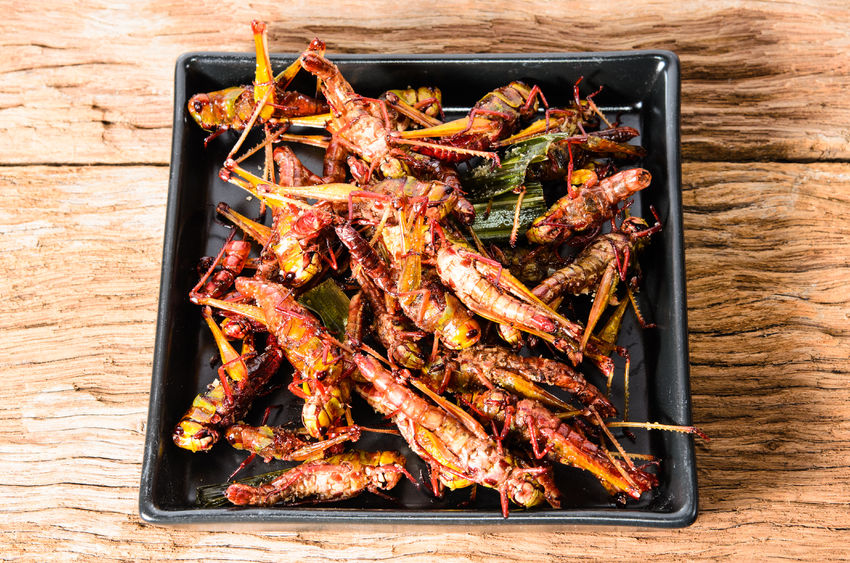The practice of eating insects is known as entomophagy. Many animals, such as spiders, lizards and birds, are entomophagous, as are many insects. People throughout the world have been eating insects as a regular part of their diets for millennia.
Why eat insects?
Overall, entomophagy can be promoted for three reasons:
- Health:
- Insects are healthy, nutritious alternatives to mainstream staples such as chicken, pork, beef and even fish (from ocean catch).
- Many insects are rich in protein and good fats and high in calcium, iron and zinc.
- Insects already form a traditional part of many regional and national diets.
- Environmental:
- Insects promoted as food emit considerably fewer greenhouse gases (GHGs) than most livestock (methane, for instance, is produced by only a few insect groups, such as termites and cockroaches).
- Insect rearing is not necessarily a land-based activity and does not require land clearing to expand production. Feed is the major requirement for land. The ammonia emissions associated with insect rearing are also far lower than those linked to conventional livestock, such as pigs. Because they are cold-blooded, insects are very efficient at converting feed into protein (crickets, for example, need 12 times less feed than cattle, four times less feed than sheep, and half as much feed as pigs and broiler chickens to produce the same amount of protein).
- Insects can be fed on organic waste streams.
- Livelihoods (economic and social factors):
- Insect harvesting/rearing is a low-tech, low-capital investment option that offers entry even to the poorest sections of society, such as women and the landless.
- Mini livestock offer livelihood opportunities for both urban and rural people.
- Insect rearing can be low-tech or very sophisticated, depending on the level of investment.
- Globally, the most common insects consumed are beetles (Coleoptera) (31 percent). This is not surprising given that the group contains about 40 percent of all known insect species. The consumption of caterpillars (Lepidoptera), especially popular in sub-Saharan Africa, is estimated at 18 percent. Bees, wasps and ants (Hymenoptera) come in third at 14 percent (these insects are especially common in Latin America). Following these are grasshoppers, locusts and crickets (Orthoptera) (13 percent); cicadas, leafhoppers, planthoppers, scale insects and true bugs (Hemiptera) (10 percent); termites (Isoptera) (3 percent); dragonflies (Odonata) (3 percent); flies (Diptera) (2 percent).
- Edible insects for sale.
- Agave worm: Also known as the maguey worm, these larvae of either the Hypopta agavis moth or the Aegiale hesperiaris are sometimes included in tequila bottles as proof of authenticity and alcohol content (tequila must be of high enough proof to preserve the worm). In Mexico, they are also eaten as part of a meal, and are highly nutritious.
- Bamboo worm: Often eaten fried in Thailand, they are the larvae of the Grass Moth, and eat their way through bamboo before metamorphosing.
- Cicada: Periodical cicadas, primarily found in the Eastern US, live underground for 17 years before emerging and molting into adults. Just after they molt, they have soft, juicy bodies, and are said to be very tender and delicious. Different species of cicada are also eaten in many Asian countries, such as Japan, Thailand, and Malaysia.
- Cockroach: Yes, you can eat cockroaches! Just not the ones you find around your house. Contrary to popular belief, cockroaches can actually be very clean and tasty insects, especially if they are fed on fresh fruits and vegetables. They can be eaten toasted, fried, sauteed, or boiled. Madagascar Hissing Cockroaches have a taste and texture like greasy chicken.
- Other popular edible insects for sale around the world listed below:
- Crickets
- Grasshoppers
- Locusts
- Scorpions
- Centipedes
- Termites
- Giant Waterbugs
- Mopane Worms
- Earthworms
- Tarantulas and so on…









